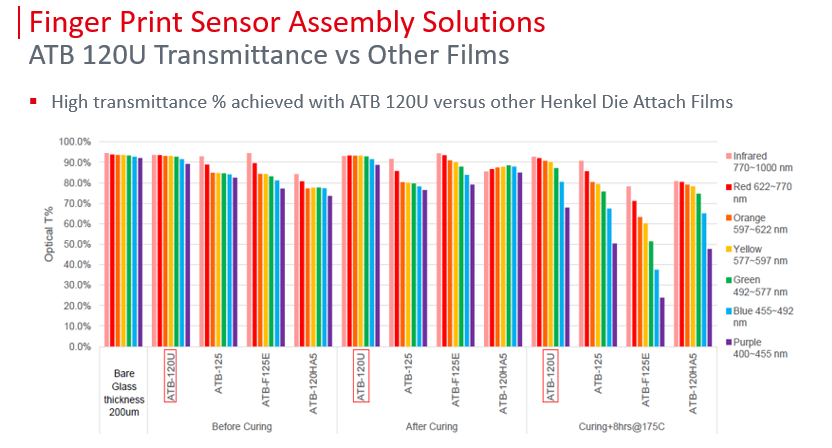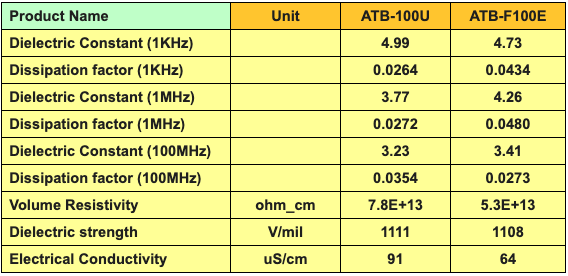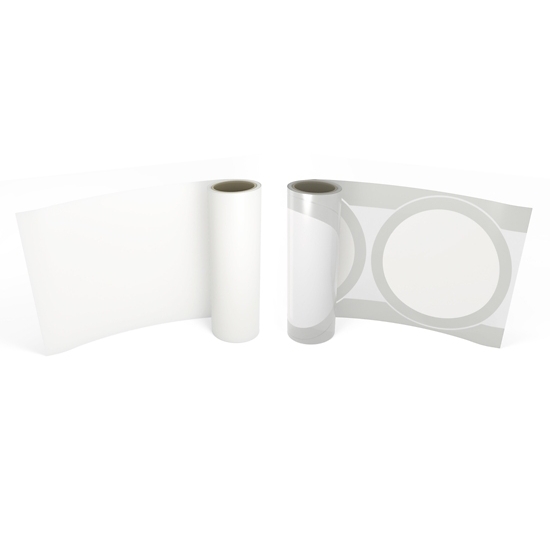LOCTITE ABLESTIK ATB 120U
- Non conductive
- Thin bondline
- Fast cure
Product Description
LOCTITE® ABLESTIK ATB 120U Non conductive adhesive film is formulated for use in wafer lamination and chip on chip processes. It combines process ease with the proven reliability of Henkel materials. It is the most transparent film available for high volume applications and is widely used for glass attach in smart phones (bonding the finger print sensor “under glass”).This 2 in 1 format is designed for base die and die to die (>1x1mm) applications, moving to thing wafer (<100um). It is a product with good workability, excellent flow ability on the substrate and a good candidate when using a Si spacer die for CoC processes.
LOCTITE® ABLESTIK ATB 120U Non conductive adhesive film has a thickness of 20um but is also available in 10, 30 and 40um. It can be used to absorb CTE mismatch between substrates but the extend to which it can be effective will depend on the bond area. The bigger the parts, the bigger the mismatch and stress. Even flexible adhesives won’t behave that flexible when thin bond lines need to absorb stress in larger bond areas. For example the glass wind shield in cars is bonded with flexible PUR adhesive with ±2-3mm bond line thickness to absorb movements. So from a Die attach film perspective, a 20um bond line will give half the stress compared to 10um!
LOCTITE® ABLESTIK ATB 120U is a medium modulus die attach film on dicing tape with 20um transparent thermoset epoxy layer that is DBG (Dicing before grinding) compatible. This means that (contrary to the "normal" process) the wafer is half cutted and the die separation happens during the backside grinding process.
Cure Schedule
- 30 minute ramp to 120°C + 30 minutes @ 120°C
Technical Specifications
| General Properties | |||||||||||
| Adhesive Thickness Adhesive Thickness Adhesive thickness indicates the thickness of an adhesive layer. It refers to the adhesive thickness of a single side so for double sided tapes it always needs to be multiplied. | 20 µm | ||||||||||
| Film Thickness Film Thickness Film thickness is the thickness of a backing film without taking into account any coatings or adhesive layers. It is measured in micron and the conversion factor to mil is 0.039. | 85 µm | ||||||||||
| Total Thickness Total Thickness Total thickness is taking into account all the films, coatings, adhesives, release liners and special layers and is the maximum thickness of a film or tape. | 105 μm | ||||||||||
| Work life @25°C Work life @25°C Work life is the amount of time we have to work with a material until it is no longer able to be easily worked and applied on a substrate. It is based on the change in viscosity and it can rely on the application requirements. | 720 hours | ||||||||||
| |||||||||||
| Chemical Properties | |||||||||||
| |||||||||||
| Mechanical Properties | |||||||||||
| |||||||||||
| |||||||||||
| Thermal Properties | |||||||||||
| |||||||||||
| Thermal Conductivity Thermal Conductivity Thermal conductivity describes the ability of a material to conduct heat. It is required by power packages in order to dissipate heat and maintain stable electrical performance. Thermal conductivity units are [W/(m K)] in the SI system and [Btu/(hr ft °F)] in the Imperial system. | 0.21 W/m.K | ||||||||||
Additional Information

ATB 120U Transmittance vs Other films light transmittance
How do you use Die attach films?
These dicing die attach adhesive films are supplied on a wafer dicing tape, being laminated on a wafer which can be diced and then a typically dry to touch “B-staged” adhesive of 10-40um will be left of the die back (of part) before final bonding step. Todays’ thinnest version is ATB 110U with 10um adhesive layer after removing the release liner and dicing tape. Note that surface roughness and warpage needs to be compensated to prevent voids during and after cure, so 20um is more commonly used.
What Dk/Df data do we have for these materials?
We do not have dk/df for these specific thicknesses but please see data at much lower frequencies on hand attached for reference
Looking at the down trend at higher frequencies and other epoxy based materials tested, we estimate Dk ~3 for these film materials at 28 GHz ...





